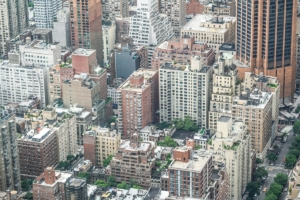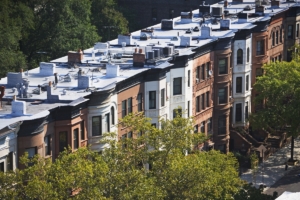Congratulations, new graduates, on your degrees and your decision to move to New York City. The next step is navigating its expensive and complex real estate market to find an apartment. While the city’s thriving economy has attracted many recent graduates, it’s also one of the reasons New York has some of the highest rents in the country.
Since the end of the last recession, the city’s private sector has added almost 100,000 new jobs per year, but rents have also grown by almost 4 percent annually. To further complicate the apartment hunt, New York City’s five boroughs each have distinct neighborhoods with their own vibes — and with varying trade-offs around commute times, affordability, and the presence of other young people.
To help you decide where to live, we created an index using four factors: ease of commute to the city’s major job centers, prevalence of apartments affordable to people making less than $60,000, concentration of other recent grads, and buildings that accept guarantors. (Which you’ll need in NYC if your combined annual income does not exceed 40 times the monthly rent.) Here’s what we found:
The Top 10 NYC Neighborhoods for College Grads
| Rank | Neighborhood | Commute | Young People | Affordability | Guarantors |
| 1 | Morningside Heights | 6 | 10 | 8 | 8 |
| 2 | Bedford-Stuyvesant | 6 | 8 | 9 | 7 |
| 3 | Financial District | 9 | 10 | 5 | 10 |
| 4 | Bushwick | 5 | 9 | 9 | 6 |
| 5 | Clinton Hill | 6 | 9 | 8 | 7 |
| 6 | Midtown South | 9 | 10 | 4 | 10 |
| 7 | Midtown West | 8 | 9 | 5 | 9 |
| 8 | Gramercy Park | 8 | 9 | 4 | 9 |
| 9 | Astoria | 5 | 8 | 9 | 6 |
| 10 | Gowanus | 6 | 7 | 9 | 9 |
Morningside Heights Has Affordability and Young People
Best for grads who are not quite ready to leave the collegiate environment, Morningside Heights has New York’s highest prevalence of people in their early 20s due to Columbia University. Some 75 percent of its apartments are 2-bedrooms under $3,000 and 3-bedrooms under $4,500 per month, meaning they’ll cost each roommate less than $1,500 each. It’s roughly a 30 minute commute from the neighborhood to Union Square and significantly less to Times Square and 59th and Lexington.
Washington Heights and Central Harlem also make our top 10 list for those who work north of Times Square, but commutes from there will take more than 30 minutes to workplaces farther south. Rents in these areas are lower than in Morningside Heights, and while they have plenty of recent grads, they won’t make you feel like you’re still in school.
Select a job center to see the best neighborhoods for commuting, then hover over them to compare:
Brooklyn Makes for an Easy Trip to Union Square
Those looking for neighborhoods with relatively low rents, many young people, and shorter commutes to Union Square or Lower Manhattan should consider the Brooklyn neighborhoods of Bed-Stuy, Clinton Hill, Bushwick, and Gowanus. Single people in their early 20s with bachelor’s degrees make up 8 to 10 percent of these neighborhoods. Almost all apartments in Bed-Stuy and Bushwick, and 3 in 4 apartments in Clinton Hill and Gowanus, will rent for less than $1,500 per roommate. The commute from these neighborhoods to Dumbo or FiDi will take 15 to 20 minutes, while the trip to Union Square will take just under 30.
If you work in Dumbo or the Financial District, Downtown Brooklyn is the neighborhood with the most convenient commute, with almost every train running through it and a similar concentration of recent graduates. Rents are much higher than elsewhere in Brooklyn, but are still lower than most neighborhoods in Manhattan. You will have to find at least two other roommates to pay less than $1,500 per person, since there are almost no 2-bedroom units under $3,000 or studios under $1,500. However, most of the apartments in the neighborhood are in new, high-rise towers equipped with gyms and outdoor space. So if you’re lucky enough to find an apartment with a group of friends, you can get a taste of luxury living in New York on an entry-level salary.
Work on the East Side? Consider Astoria
Few neighborhoods have it all, and the ones that have the most tend to be in the outer boroughs or in Upper Manhattan. The Queens neighborhood of Astoria is an ideal place for recent grads who work near the 59th and Lexington subway stop, but anyone who works in Union Square or above should be able to reach their destination from Astoria in around 30 minutes. Almost 7 percent of Astoria residents are single people in their early 20s, which is above the 75th percentile for neighborhoods across New York City. Almost all apartments there will be affordable to someone making less than $60,000 who lives with a roommate, giving new grads plenty of options. Moreover, while the neighborhood is quieter than most Manhattan neighborhoods at night, it still has lively bars and restaurants that serve cuisine from around the world.
FiDi and Midtown Are Great — If You Have a Guarantor
Those who want the fastest commute to work and wish to live in Manhattan will face a tradeoff between convenience and affordability. Midtown, Gramercy Park, and the Financial District are all great for new grads, but are among the most expensive neighborhoods in the city. Living in any of these neighborhoods will get you to work in 5 to 20 minutes if you work between 59th and Lexington and Dumbo. Despite the high cost of living — the likelihood of finding a room for less than $1,500 here is a third of what it would be in the Brooklyn and Queens neighborhoods on this list — these areas have some of the highest concentration of recent graduates in the city.
Many apartments here, especially the high rises, attract new grads by accepting guarantors — parents or family members willing to cosign the lease. Guarantors are required if the tenants combined do not annually earn 40 times the monthly rent, and guarantors themselves must make 80 times the monthly rent. (If you don’t have family members or friends so flush, third-party services will cosign for you — for a fee, of course.) While guarantors are common in some Manhattan areas, few of the more affordable buildings in Brooklyn and Queens advertise that they accept them. It’s always good to check, though, since older buildings will often accept guarantors but not advertise it.
The Lower East Side, East Village, and Greenwich Village are other options in Manhattan with plenty of young people and quick commutes to most job centers. Most apartments here are in prewar, walk-up buildings, and will require three or more roommates to get the cost under $1,500 per person. However, these Lower Manhattan neighborhoods are highly attractive to recent grads. Their proximity to NYU and eclectic histories ensures a vibrant nightlife, some of the best restaurants, bars, and coffee shops in the city, and creative vibes. They are great options if you can score a good deal — but keep in mind that you have a smaller likelihood of finding a building that accepts guarantors than in Midtown.
Of course, the best neighborhood for a new grad is ultimately a personal choice, and depends on factors beyond the ones we’ve considered here. We hope this guide is a helpful tool to get you started in your neighborhood search. Be sure to check out our Renters Guide and our Moving to NYC Guide for more advice.
How We Did It
We ranked each neighborhood on a percentile basis for four factors relative to other NYC neighborhoods: affordability, buildings that accept guarantors, commute time, and prevalence of new grads.
Most New York apartments require an annual income of 40 times the monthly rent, or a guarantor who earns 80 times it. Given that, we ranked neighborhoods based on the share of 2-bedroom apartments under $3,000 a month and the share of 3-bedroom apartments under $4,500. These cutoffs are to ensure a maximum of $1,500 per person, and thus affordability to those with an annual income of $60,000. Nationwide, the average starting salary for a new graduate is roughly $51,000 as of 2017, but jobs in New York City tend to pay more.
We used StreetEasy commute data from each neighborhood to the major job centers of the Financial District, Dumbo, Times Square, Union Square, and 59th Street and Lexington Avenue. Our overall list looks at neighborhoods with the fastest commute times to any of these destinations. Finally, we used data from U.S. Census 2016 American Community Survey to rank neighborhoods based on the share of their population consisting of people 24 years old and younger with bachelor’s degrees who have never married.
—
Hey, why not like StreetEasy on Facebook and follow @streeteasy on Instagram?










